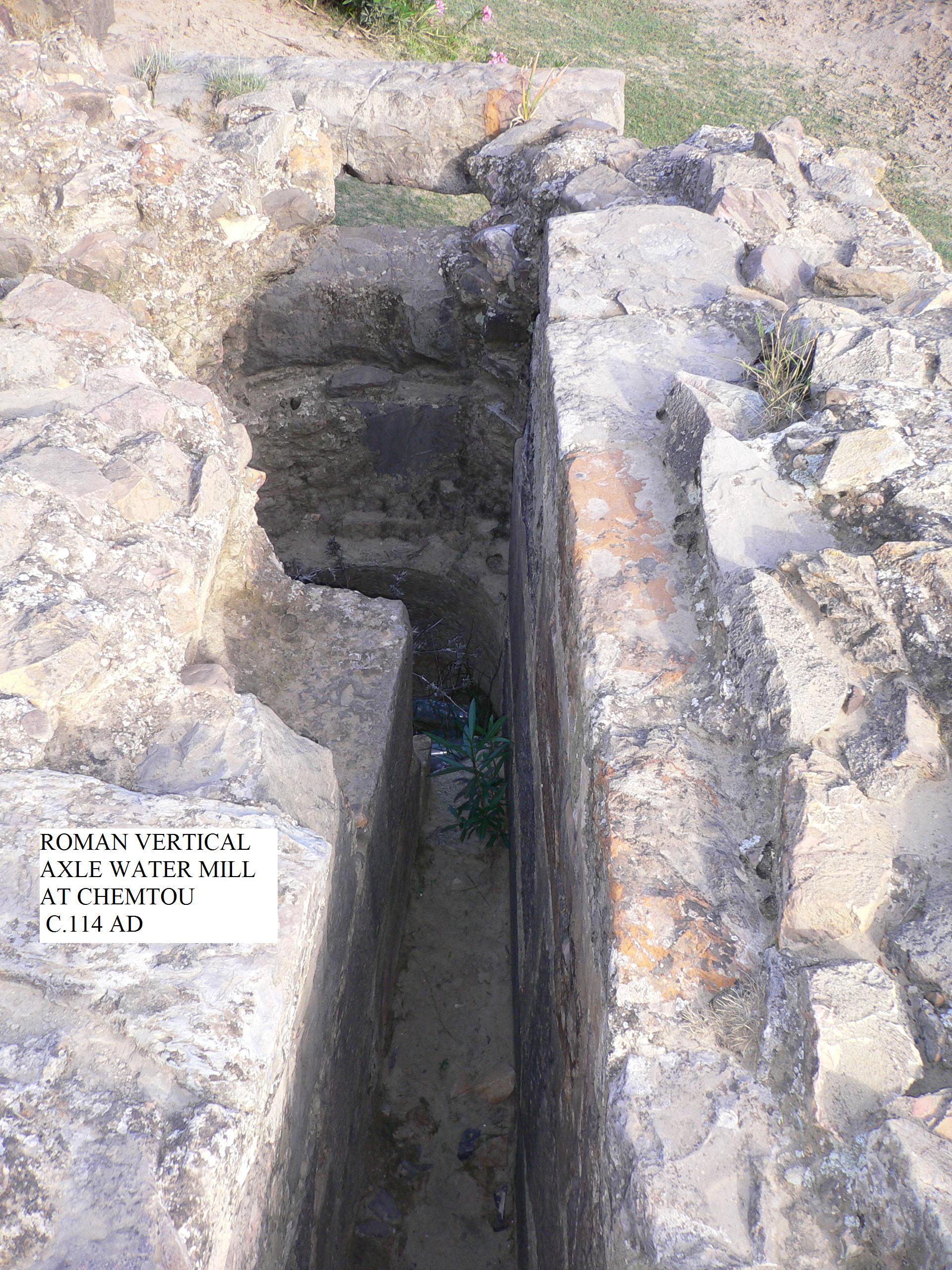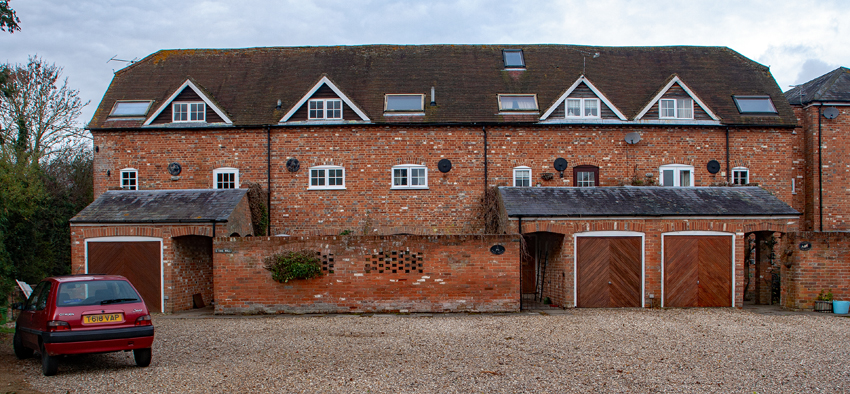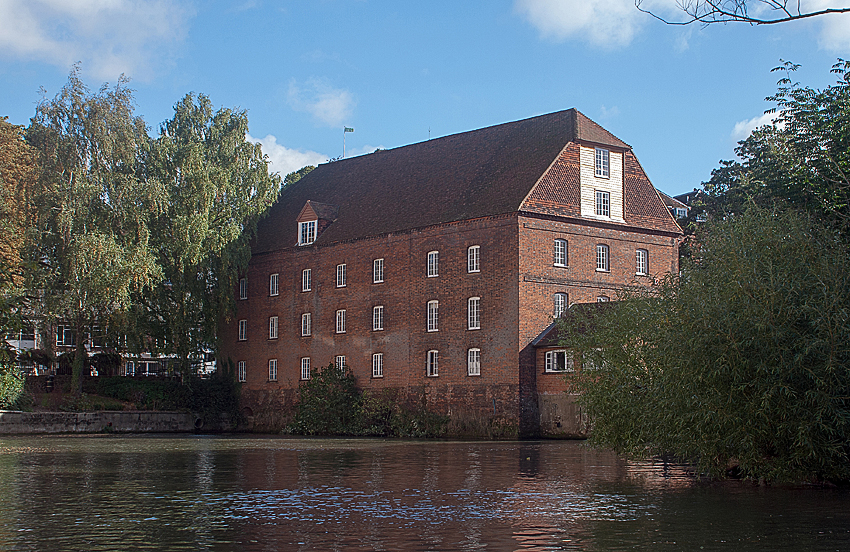|
Town Mill, Guildford
The Town Mill is a Grade II listed 18th-century watermill located in the centre of Guildford on the River Wey. History The earliest recorded mill on the site was one constructed by Walter de la Poyle in 1295. This was a fulling mill as Guildford was an important location in the wool trade. This was probably the mill known as Kings Mill. By the late 17th century the mill had been extended to include corn milling with 4 pairs of stones, two for flour and two for animal feed. The whole assembly was driven by three external water wheels. The construction of the Wey Navigation was a boon for the mill, enabling grain to be delivered to the mill by barge and the resulting sacks of flour to be taken, again by barge, to London. By 1768, the buildings had become rather dilapidated and the eastern range was demolished and replaced by a three-storey red brick edifice with dentil moulding under the eaves of a tiled roof. The western range was simply repaired and continued in use. This s ... [...More Info...] [...Related Items...] OR: [Wikipedia] [Google] [Baidu] |
Watermill
A watermill or water mill is a mill that uses hydropower. It is a structure that uses a water wheel or water turbine to drive a mechanical process such as mill (grinding), milling (grinding), rolling, or hammering. Such processes are needed in the production of many material goods, including flour, lumber, paper, textiles, and many metal products. These watermills may comprise gristmills, sawmills, paper mills, textile mills, hammermills, trip hammering mills, rolling mills, and wire drawing mills. One major way to classify watermills is by wheel orientation (vertical or horizontal), one powered by a vertical waterwheel through a Gear train, gear mechanism, and the other equipped with a horizontal waterwheel without such a mechanism. The former type can be further subdivided, depending on where the water hits the wheel paddles, into undershot, overshot, breastshot and pitchback (backshot or reverse shot) waterwheel mills. Another way to classify water mills is by an essential tr ... [...More Info...] [...Related Items...] OR: [Wikipedia] [Google] [Baidu] |
Renewable Energy
Renewable energy (also called green energy) is energy made from renewable resource, renewable natural resources that are replenished on a human lifetime, human timescale. The most widely used renewable energy types are solar energy, wind power, and hydropower. Bioenergy and geothermal power are also significant in some countries. Some also consider Nuclear power proposed as renewable energy, nuclear power a renewable power source, although this is controversial, as nuclear energy requires mining uranium, a nonrenewable resource. Renewable energy installations can be large or small and are suited for both urban and rural areas. Renewable energy is often deployed together with further electrification. This has several benefits: electricity can heat pump, move heat and Electric vehicle, vehicles efficiently and is clean at the point of consumption. Variable renewable energy sources are those that have a fluctuating nature, such as wind power and solar power. In contrast, ''contro ... [...More Info...] [...Related Items...] OR: [Wikipedia] [Google] [Baidu] |
Grinding Mills In The United Kingdom
Grind is the cross-sectional shape of a blade. Grind, grinds, or grinding may also refer to: Grinding action * Grinding (abrasive cutting), a method of crafting * Grinding (dance), suggestive club dancing * Grinding (video gaming), repetitive and uninteresting gameplay * Bruxism, grinding of the teeth * Grind (sport), a sliding stance usually performed in extreme sports such as aggressive skating and boardsports ** Grind (skateboarding) * Grind (whaling), pilot whale hunting in the Faroe Islands * Grinds, private tutoring, in Ireland * Mill (grinding) * Grinding, the operation of the winches on a yacht; the work done by a grinder (sailing position) Geography * Grind, a village in Lăpugiu de Jos Commune, Hunedoara County, Romania * Grind (Unirea), a tributary of the Unirea in Cluj and Alba Counties, Romania Film and TV * ''Grind'' (2003 film), about amateur skaters * ''The Grind'' (1915 film), a silent movie * ''Grind'' (1997 film), starring Billy Crudup and Adrienne Shell ... [...More Info...] [...Related Items...] OR: [Wikipedia] [Google] [Baidu] |
Flour Mills In The United Kingdom
Flour is a powder made by Mill (grinding), grinding raw grains, List of root vegetables, roots, beans, Nut (fruit), nuts, or seeds. Flours are used to make many different foods. Cereal flour, particularly wheat flour, is the main ingredient of bread, which is a staple food for many cultures. Maize flour, Corn flour has been important in Mesoamerican cuisine since ancient times and remains a staple in the Americas. Rye flour is a constituent of bread in both Central Europe and Northern Europe. Cereal flour consists either of the endosperm, cereal germ, germ, and bran together (whole-grain flour) or of the endosperm alone (refined flour). ''Meal'' is either differentiable from flour as having slightly coarser particle size (degree of comminution) or is synonymous with flour; the word is used both ways. The Centers for Disease Control and Prevention, CDC has cautioned not to eat raw flour doughs or batters. Raw flour can contain harmful bacteria such as ''E. coli'' and needs ... [...More Info...] [...Related Items...] OR: [Wikipedia] [Google] [Baidu] |
Grade II Listed Buildings In Surrey
Grade most commonly refers to: * Grading in education, a measurement of a student's performance by educational assessment (e.g. A, pass, etc.) * A designation for students, classes and curricula indicating the number of the year a student has reached in a given educational stage (e.g. first grade, second grade, K–12, etc.) * Grade (slope), the steepness of a slope * Graded voting Grade or grading may also refer to: Music * Grade (music), a formally assessed level of profiency in a musical instrument * Grade (band), punk rock band * Grades (producer), British electronic dance music producer and DJ Science and technology Biology and medicine * Grading (tumors), a measure of the aggressiveness of a tumor in medicine * The Grading of Recommendations Assessment, Development and Evaluation (GRADE) approach * Evolutionary grade, a paraphyletic group of organisms Geology * Graded bedding, a description of the variation in grain size through a bed in a sedimentary rock * Metamorphic ... [...More Info...] [...Related Items...] OR: [Wikipedia] [Google] [Baidu] |
Historic Sites In England
History is the systematic study of the past, focusing primarily on the human past. As an academic discipline, it analyses and interprets evidence to construct narratives about what happened and explain why it happened. Some theorists categorize history as a social science, while others see it as part of the humanities or consider it a hybrid discipline. Similar debates surround the purpose of history—for example, whether its main aim is theoretical, to uncover the truth, or practical, to learn lessons from the past. In a more general sense, the term ''history'' refers not to an academic field but to the past itself, times in the past, or to individual texts about the past. Historical research relies on primary and secondary sources to reconstruct past events and validate interpretations. Source criticism is used to evaluate these sources, assessing their authenticity, content, and reliability. Historians strive to integrate the perspectives of several sources to develop a ... [...More Info...] [...Related Items...] OR: [Wikipedia] [Google] [Baidu] |
Watermills In Surrey
A watermill or water mill is a mill that uses hydropower. It is a structure that uses a water wheel or water turbine to drive a mechanical process such as milling (grinding), rolling, or hammering. Such processes are needed in the production of many material goods, including flour, lumber, paper, textiles, and many metal products. These watermills may comprise gristmills, sawmills, paper mills, textile mills, hammermills, trip hammering mills, rolling mills, and wire drawing mills. One major way to classify watermills is by wheel orientation (vertical or horizontal), one powered by a vertical waterwheel through a gear mechanism, and the other equipped with a horizontal waterwheel without such a mechanism. The former type can be further subdivided, depending on where the water hits the wheel paddles, into undershot, overshot, breastshot and pitchback (backshot or reverse shot) waterwheel mills. Another way to classify water mills is by an essential trait about their location: tid ... [...More Info...] [...Related Items...] OR: [Wikipedia] [Google] [Baidu] |
List Of Watermills In The United Kingdom
The use of water power in Britain was at its peak just before the Industrial Revolution. The need for power was great and steam power had not yet become established. It is estimated that at this time there were well in excess of ten thousand watermills in the country. Most of these were corn mills (to grind flour), but almost any industrial process needing motive power, beyond that available from the muscles of men or animals, used a water wheel, unless a windmill was preferred. Today only a fraction of these mills survive. Many are used as private residences, or have been converted into offices. At least one is now a whiskey distillery, and another is a gin distillery. A number have been preserved or restored as museums where the public can see the mill in operation. This is a list of some of the surviving watermills and tide mills in the United Kingdom. England Bedfordshire *Bowman's Watermill, Astwick *Bromham Watermill, Bromham *Clophill Watermill, Clophill *Hulco ... [...More Info...] [...Related Items...] OR: [Wikipedia] [Google] [Baidu] |
Mills On The River Wey And Its Tributaries
Many watermills lined the banks of the River Wey, England, from the 17th century, due to the river's ability to provide a reliable, year-round flow of water. These mills chiefly ground wheat, often referred to as corn, for flour and oats for animal feed though many were used in the production of other goods such as paper, cloth, leather, wire and gunpowder. The river was home to more mills per mile than anywhere else in Great Britain. The mill situated at Coxes Lock near Addlestone, Surrey, is the largest. There are many mills on the river's principal tributaries, such as the River Tillingbourne, Tillingbourne and the River Ock, Surrey, Ock, as well as mills on the Whitmore Vale stream, Cranleigh Waters and Hodge Brook. The last commercial mill on the Tillingbourne, Botting's Mill at Albury, closed in 1991. Headley Water Mill, on the Wey South branch is still in business. Town Mill, Guildford still has a water turbine driven generator producing electricity for the town. Note: The ... [...More Info...] [...Related Items...] OR: [Wikipedia] [Google] [Baidu] |
Dapdune Wharf
Dapdune Wharf is a former industrial wharf and boat yard on the Wey and Godalming Navigations in Guildford, England, UK, close to the Surrey County Cricket Club ground. It is now maintained by the National Trust. Originally a goods transshipment point, before the construction of the Godalming Navigation the principal cargos were timber from the Surrey forests and gunpowder from the works at Chilworth, as the Guildford authorities refused to let it pass through the town centre for loading at the town wharf. For a period of time at the beginning of the 20th Century, Dapdune Wharf was the centre of barge building on the Wey Navigation. Dapdune is now the starting point for boat trips, including boat hire. The Visitor Centre has interactive displays, a smithy, a stable, and two of the three remaining Wey barges in the world - the ''Reliance'', permanently damaged and kept in a graving (dry) dock, and '' Perseverance IV'', still floating but in need of repair and the subject of a ... [...More Info...] [...Related Items...] OR: [Wikipedia] [Google] [Baidu] |
National Grid (UK)
The National Grid is the high-voltage electric power transmission network supporting the UK's electricity market, connecting power stations and major substations, and ensuring that electricity generated anywhere on the grid can be used to satisfy demand elsewhere. The network serves the majority of Great Britain and some of the surrounding islands. It does not cover Northern Ireland, which is part of the Irish single electricity market. The National Grid is a wide area synchronous grid operating at 50 hertz and consisting of 400 kV and 275 kV lines, as well as 132 kV lines in Scotland. It has several undersea interconnectors: an AC connector to the Isle of Man, and HVDC connections to Northern Ireland, the Shetland Islands, the Republic of Ireland, France, Belgium, the Netherlands, Norway, and Denmark. Ownership Since the privatisation of the Central Electricity Generating Board in 1990, the grid in England and Wales is owned by National Grid Electricity Transmission. I ... [...More Info...] [...Related Items...] OR: [Wikipedia] [Google] [Baidu] |
Kilowatt-hour
A kilowatt-hour ( unit symbol: kW⋅h or kW h; commonly written as kWh) is a non-SI unit of energy equal to 3.6 megajoules (MJ) in SI units, which is the energy delivered by one kilowatt of power for one hour. Kilowatt-hours are a common billing unit for electrical energy supplied by electric utilities. Metric prefixes are used for multiples and submultiples of the basic unit, the watt-hour (3.6 kJ). Definition The kilowatt-hour is a composite unit of energy equal to one kilowatt (kW) multiplied by (i.e., sustained for) one hour. The International System of Units (SI) unit of energy meanwhile is the joule (symbol J). Because a watt is by definition one joule per second, and because there are 3,600 seconds in an hour, one kWh equals 3,600 kilojoules or 3.6 MJ."Half-high dots or spaces are used to express a derived unit formed from two or more other units by multiplication.", Barry N. Taylor. (2001 ed.''The International System of Units.'' (Special publicatio ... [...More Info...] [...Related Items...] OR: [Wikipedia] [Google] [Baidu] |






